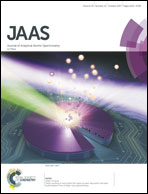A low-blank two-column chromatography separation strategy based on a KMnO4 oxidizing reagent for Cr isotope determination in micro-silicate samples by thermal ionization mass spectrometry
Abstract
This study has led to a new technique for the separation of Cr from small silicate samples (0.3–2 mg) and determination of stable Cr isotopes in silicates by double spike thermal ionization mass spectrometry (DS-TIMS). Based on our recent two-step exchange resin scheme (Li et al., JAAS, 2016, 31, 2375), we further significantly reduced the procedural blank and improved Cr recovery (94.7–97.5%) from a range of complex silicate rocks varying in composition from andesite to ultra-mafic, and carbonates as well. The key improvement is that KMnO4 was employed to replace conventional (NH4)2S2O8 as the oxidizing reagent, which reduces the procedural blank from 1–20 ng in previous studies to 0.15 ± 0.04 ng (n = 8). In addition, the inhibition effect on the Cr signal caused by residual SO42− in the Cr fraction using the conventional method has been completely eliminated during TIMS measurements. This permits the high precision determination of Cr isotopic ratios from geological samples as small as ∼46 ng. This chemical procedure was verified using a variety of silicate rocks in the size range of 0.3–2 mg. A series of analyses demonstrated that it is possible to attain internal precisions (2 SE) of ±0.03 to 0.06‰. Replicate digestions and analyses of basalt standard BIR-1 with a sample size of 0.3 mg (δ53Cr = −0.158 ± 0.052‰, 2 SD) demonstrated that good intermediate precision is obtainable for extremely small silicate samples.



 Please wait while we load your content...
Please wait while we load your content...